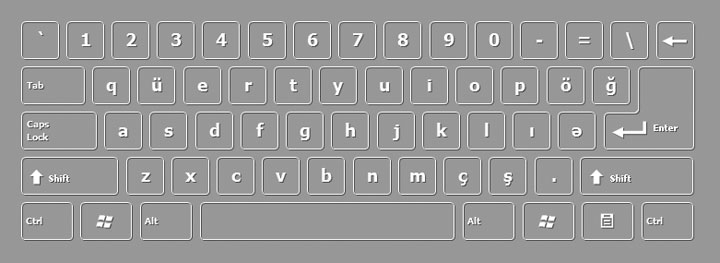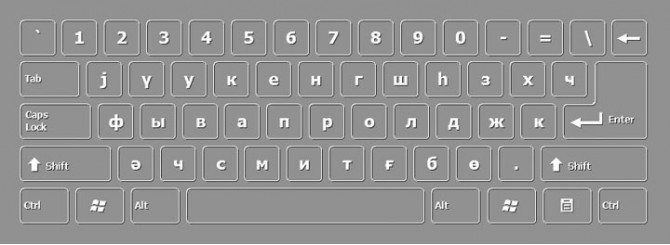AZERBAIJANI DESKTOP KEYBOARD FREE DOWNLOAD
Cyrillic and Latin AZERBAIJANI layouts

Frontype is easy to use multilingual user-friendly virtual onscreen keyboard that turns any keyboard to your language layout. Just add needed language as input and start to type!
Azerbaijani (/ˌæzərbaɪˈdʒɑːni/, /ˌɑː-/, /-ˈʒɑːni/) or Azeri (/æˈzɛəri/, /ɑːˈ-/ /əˈ-/), also referred to as Azerbaijani Turkish[4] or Azeri Turkish,[5][6] is a Turkic language spoken primarily by the Azerbaijanis, who are concentrated mainly in Transcaucasia. The language has official status in Azerbaijan and Dagestan (a federal subject of Russia) but it does not have official status in Iranian Azerbaijan, where the majority of Azerbaijanis live. It is also spoken to lesser varying degrees in Azerbaijani communities of Georgia, Iraq, and Turkey and by diaspora communities, primarily in Europe and North America.
Azerbaijani is a member of the Oghuz branch of the Turkic languages. It has two primary divisions, North Azerbaijani (spoken in the Republic of Azerbaijan and Russia) and South Azerbaijani (spoken in Iran), and is closely related to Turkish, Qashqai, Turkmen and Crimean Tatar, sharing varying degrees of mutual intelligibility with each of those languages.
Azerbaijani has been a literary language since at least the 13th century and was the court language of the Safavids and Afsharids dynasties. Azerbaijani was also a lingua franca throughout the Caucasus starting in the 16th century. The Russian conquest of parts of Azerbaijan in the 18th and 19th centuries and subsequent attempts by Iran, the USSR, and Turkey to influence the development of the language resulted in the development of significant differences in script, phonology, lexicon, morphology, syntax, and loanwords between North Azerbaijani and South Azerbaijani.
Before 1929, Azerbaijani was written only in the Persian version of the Arabic alphabet. In 1929–1938 a Latin alphabet was in use for North Azerbaijani (although it was different from the one used now), from 1938 to 1991 the Cyrillic script was used, and in 1991 the current Latin alphabet was introduced, although the transition to it has been rather slow. In Iran, Azerbaijani is still written in the Persian alphabet, and in Dagestan, in Cyrillic script.
The Azerbaijani alphabet is an abjad; that is, it does not represent vowels. Also, some consonants can be represented by more than one letter. The Cyrillic and Latin alphabets have no such flaws. The Azerbaijani Latin alphabet is based on the Turkish Latin alphabet because of their linguistic connections and mutual intelligibility. The letters Әə, Xx, and Qq are available only in Azerbaijani for sounds which do not exist as separate phonemes in Turkish.
Notice that Azerbaijani has informal and formal ways of saying things. This is because there is more than one meaning to "you" in Turkic languages like Azerbaijani and Turkish (as well as in many other languages). The informal you is used when talking to close friends, relatives, animals or children. The formal you is used when talking to someone who is older than you or someone for whom you would like to show respect (a professor, for example). As in many Romance languages, personal pronouns can be omitted, and they are only added for emphasis. Azerbaijani is a very phonetic language, so pronunciation is very easy. Most words are pronounced exactly as they are spelled in modern Azeri alphabet.
Write a review about AZERBAIJANI DESKTOP KEYBOARD FREE DOWNLOAD
Your Name:Your Review: Note: HTML is not translated!
Rating: Bad Good
Enter the code in the box below:






















